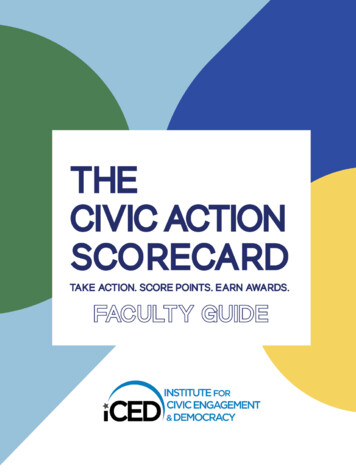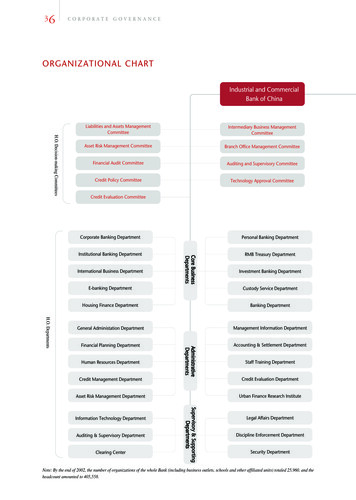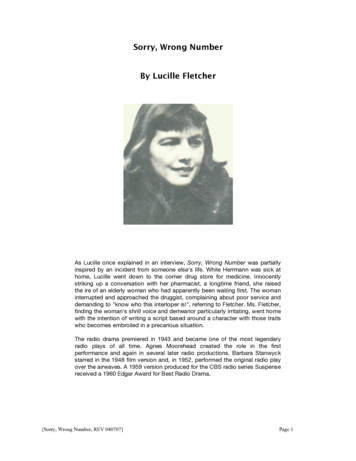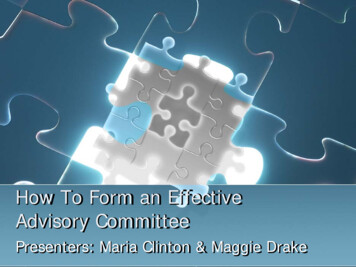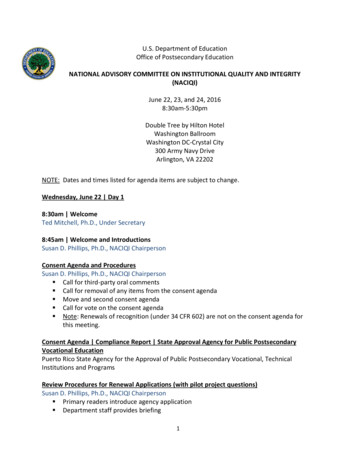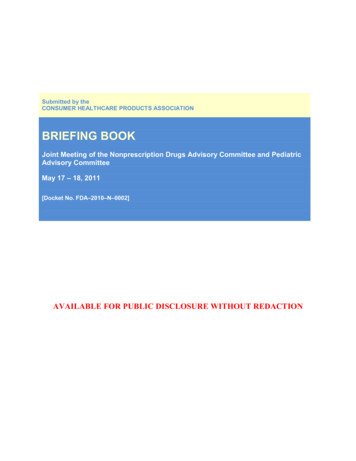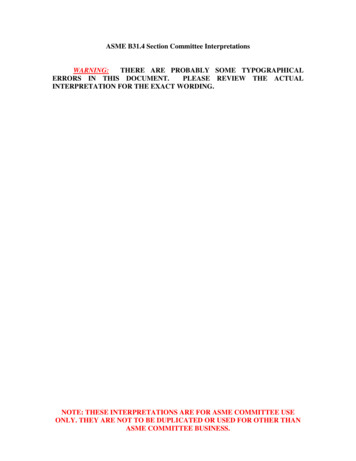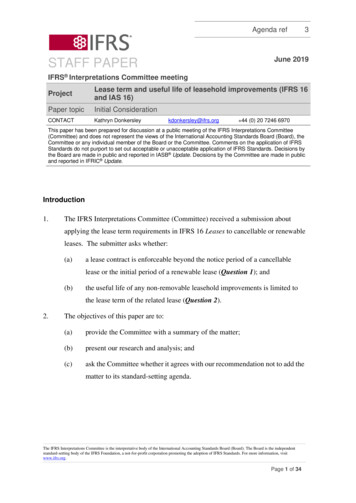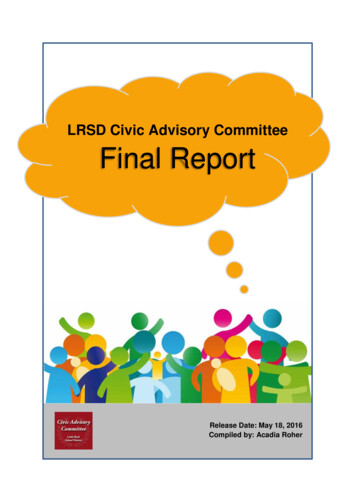
Transcription
LRSD Civic Advisory CommitteeFinal ReportRelease Date: May 18, 2016Compiled by: Acadia Roher
Table of ContentsExecutive Summary 2Acknowledgements .4List of LRSD CAC Members .5Introduction .6Methodology .7Findings .8An excellent education for all children . 10Student realities and life in the schools .18Infrastructure challenges and needs 25Teachers and quality instruction 29Community engagement in education .32Recommendations .37Appendix A: Forum facilitation guide .38Appendix B: Facilities Subcommittee Report .402015-2016 LRSD CAC Members1
Executive SummaryThe Little Rock School District Civic Advisory Committee (LRSD CAC), established by the StateBoard of Education after the takeover of the Little Rock School District, was commissioned torepresent the concerns and ideas of the students, parents, teachers, and community membersof the district in the absence of an elected school board. Community forums, surveys, and otheractivities were undertaken by the LRSD CAC during the spring of 2016.About 250 stakeholders participated in a total of 33 small group discussions over the course offive forums. Participants discussed a variety of topics ranging from broad concerns about thelack of information and transparency in the school district to specific details of wraparoundservice needs such as health care and meals. Many of these issues remain relevant in the faceof rapid changes in the district, many of which have been concerns for decades. The findingsare grouped into five sections. Many themes fit into multiple categories and all topics areinterconnected.The first section explores the barriers and keys to providing a quality education for all children.Key findings: The ongoing challenge of neighborhood schools is that the student bodies becomehomogenous based on the racial and socioeconomic divisions of Little Rock’sneighborhoods. The lack of clarity, transparency, and stability in the district is causing families to movetheir children to other educational institutions. Several participants stated that they would support a millage increase, and that if passedit should be allocated to schools with the highest needs. Participants pointed out that charter schools perform no better than traditional schools bythe numbers, but the perception that charters are superior persists.The second section focuses on student realities and life in the schools, including literacy,extracurriculars, discipline, class sizes, and ESOL. Key findings: A little over one third of groups discussed testing and not one recorded comment was infavor of the current testing regime. Participants unanimously agreed that smaller class sizes were needed in the LRSD. There was consensus among groups that recess and physical activity needs to beincreased. Increased physical activity has been linked to better focus in children. Participants expressed that the test used to determine the need for services lumps allLatinos in together rather than focusing on new immigrants and their language accessneeds, and that some children with sufficient English skills are being tracked into ESOLprograms.The third section covers infrastructure challenges and needs. Key findings: Many comments centered on outrage over stark disparities between newer and olderschool buildings. Putting money into new schools is upsetting to families whose children attend school inolder buildings that are not being adequately or safely maintained. Participants felt thatall schools should be held to a high standard of health and safety.2
The majority of forum participants were opposed to any school closings, describing thepotential impact of closed schools on their neighborhoods, as they have seen previousschool closings create a hole in communities nearby.The fourth section discusses teachers and quality instruction. Key findings: There is a clear sentiment that the LRSD needs teachers who are motivated, openminded, inspiring, and content. However, groups discussed at length the reasons that somany teachers are feeling stressed, drained, and hopeless. Most teachers at the forums expressed a noted decrease in support. Perspectives on Teach For America were negative across the board.The final section covers community engagement in education. Key findings: Participants asked, “Are our voices heard? Do the powers that be pay any attention tous?” Many expressed feeling unheard after putting in the time and effort to give theirinput. Participants suggested that students are the experts on their schools and they should beconsulted directly about changes that are needed. Administrators described a range of needs that community volunteers could fill, frombringing umbrellas to cover students entering the school on rainy days to providingliteracy help to students reading below grade level. There was a sense that the business community was responsible for the state takeoverand thus should be sponsoring schools in more tangible ways at all levels, not justsupporting elementary schools.Recommendations will be released at the CAC Report Back on May 19th, 2016 at 5:00p.m. atHorace Mann Magnet Middle School.There is more urgency than ever about the need to take stock of the LRSD’s challenges andopportunities, and chart a path forward that allows every child the chance to thrive.3
AcknowledgementsThe work of the Little Rock School District Civic Advisory Committee (LRSD CAC) has been acollaborative process among dozens of students, school staff, community stakeholders, andvarious organizations. The members of the 2015-2016 LRSD CAC are listed on the followingpage.A major portion of the LRSD CAC’s work consisted of planning and implementing communityforums that were spearheaded by the Community Engagement Subcommittee of the LRSDCAC: Anika Whitfield-Chair, Gene Levy-Co-chair, Nanette Patino, Dionne Jackson, AlexisWilliams, Seketa Ross, and three student representatives. Additionally, the series of communityforums would not have been possible without the hundreds of people who came together on ashort timeline to provide their time and talent, including Acadia Roher and Jennifer Henderson,who supported the management of this process through the generosity of the WinthropRockefeller Foundation and the Arkansas Public Policy Panel.We are so very grateful to the host sites for the forums: Wakefield Elementary, Centro CristianoHispano, Gibbs Magnet Elementary, Saint Mark Baptist Church, and Roberts Elementary. Wealso appreciate the schools that hosted LRSD CAC meetings over the course of the year. Thestaff and administrators were a pleasure to work with.Many thanks to our volunteers: Ashley Bachelder, Diane Vibhakar, Horace Smith, ConnieWhitfield, Jenna Greer, Regan Moffitt, Bill Kopsky, Greg Adams, Liz Lucker, Janie Stultz,Meredith Morrison, Jennifer Guzman, Hersch Rothmel, Mary Wolf, Marion Humphrey, LeticiaReta, Merrill Schmidt, Ruth Shepherd, Akaylah Jones, Kymara Seals, Carol Young, AmberJackson, Hilary Trudell, Helen Grace King, Tamika Edwards, Jerri Derlikowski, Nell Matthews,Alex Handfinger, David Monteith, Amy Johnson, Arjola Limani, Debbie Milam, Ana Phakhin,Connie Whitfield, Cathy Koehler, Sharon Jackson, Sandra Ledbetter, Ti Davis, KyleLeyenberger, John Wilkerson, Debra Bowers, Beverly Broadnax-Thrasher, Glory Pearsall,Gwendolyn Jones, Amanda Maher, James Szenher, Ashley Moore, Claire Smyth, and JaneciaCollins, and several others who pitched in as needed.Each forum included performances by highly talented LRSD students. Over 150 studentsperformed or served in other volunteer roles. They include: McClellan choir McClellan DECA, Unitown, and FBLA volunteers Baseline cheer and choir Hall AVID volunteers McDermott Student Council volunteers Henderson Diamond Divas volunteers Booker Arts orchestra, choir, and drama Williams choir and flag line Roberts choir and flag line Roberts PTSA volunteers4
List of LRSD CAC MembersThe zone members and philanthropic organizations appointed in 2015 were:Zone 1Joy SpringerZone 2Anika WhitfieldZone 3Peter GessZone 4 and Co-chairDionne B. JacksonZone 5John L. WilkersonZone 6Marq GoldenZone 7Brenda "BJ" WyrickCo-ChairGreg AdamsPhilanthropic OrganizationsLittle Rock Public Education Foundation Eugene LevyArkansas Hunger Relief Alliance - KathyWebbLatino Community MemberRepresentativeTerry Trevino-RichardTeachers include:Baseline Elementary SchoolDeborah CavenerLatonya JacksonUpdated Teacher Representation atBaseline as of September 7, 2015Tamika JordanNanette PatinoCloverdale Middle SchoolBrooke SandersYasmine ButteUpdated Teacher Representative at CloverdaleRitchie HollimanHenderson Middle SchoolSandra LedbetterTiffani JonesFair High SchoolSharon JacksonFred DickinsHall High SchoolLiz LuckerTracy MasonUpdated Teacher Representative at HallAmanda WarrenMcClellan High SchoolSeketa RossDeborah HansberryStudent RepresentationTwo students from each of the sixacademically distressed schools listedabove5
IntroductionThe Civic Advisory Committee, established by the State Board of Education after the takeoverof the Little Rock School District, was commissioned to represent the concerns and ideas of thestudents, parents, teachers, and community members of the district in the absence of anelected school board. The forums, surveys, and other activities undertaken by the LRSD CACduring the spring of 2016 were a key part of their work to reach out to constituents and providespace for discussion, questions, and data gathering. Much has happened in the LRSD since thetakeover. The results described in this report represent a snapshot of attitudes before severalmajor changes ensued, including the approval of a major expansion of charter schools inPulaski County and the appointment of a new Superintendent. Reports on the work of LRSDCAC subcommittees are included in the appendix.The information gathered at the forums covered a wide array of issues, all of which remainrelevant in the face of rapid changes in the district, and many of which have been concerns fordecades. Against a backdrop of a shrinking budget, distressed schools, pressure on teachers,the increase of high stakes testing, and a persistent achievement gap, residents of Little Rockcame together to hash out their vision for ideal schools, discuss issues, and propose solutions.There are many incredible success stories and pockets of excellence in the LRSD, but there arealso inequities that exist that fall along clear race and class lines. Many forum participants calledfor a solid plan forward to ensure the success of every school and every child. The largerpolitical environment has made this goal increasingly difficult. There is more urgency than everabout the need to take stock of the LRSD’s challenges and opportunities, and chart a pathforward that allows every child the chance to thrive.Image: LRSD CAC Co-chair Dionne Jackson opens the first forum at Wakefield Elementary.6
MethodologyThe LRSD CAC utilized community forums and surveys to gather data from LRSD stakeholders.The Community Engagement Subcommittee (“Subcommittee”) held a series of five forums atdifferent locations around Little Rock during February and March of 2016. Each forum lastedtwo hours and started with a welcome and video on the current state of the LRSD, then movedinto small group discussions led by a trained facilitator using a facilitation plan (see Appendix A).The questions guided each focus group, but also allowed for a free-flowing dialogue betweenthe facilitator and participants. Facilitators and/or designated notetakers captured handwrittennotes from each table discussion. Participants also co-created images on large sheets of paperto describe their vision for excellent schools in Little Rock. Finally, participants were asked tosubmit questions on Post-It notes, turn in a commitment card noting their willingness tocontribute to improving the schools, and fill out an evaluation of the forum experience. Noteswere transcribed for each small group discussion, then used to identify themes. Each set ofnotes was coded using the major themes to determine the frequency with which different topicswere discussed across all forums.Subcommittee members created the first drafts of the surveys for elementary students, middleand high school students, parents, and school staff, which were then shared with other LRSDCAC members and LRSD staff to gather further input. Survey questions covered schoolinformation, experiences at school, perceptions of parent and community involvement, andneeds for improvement. Participants were also asked if they would be willing to get involved inefforts to improve their schools. A Spanish language version of each survey was also createdfor monolingual Spanish speakers. The surveys were administered on paper and online in April2016. LRSD staff sent surveys to each school to complete. Survey results are not included inthis report but will be forthcoming.The flurry of activity around community input inspired several additional engagement activities,including one teacher who copied the forum’s structure and gathered input from her students atHall High School.7
FindingsNearly 600 people signed in at the five forums. Of those, about 250 stayed the entire two hoursand engaged fully in the small group discussions. The discrepancy can be attributed to the factthat many of those who signed in were family members of students performing or volunteeringand were either not aware that the forums were seeking their input or had other familyresponsibilities. Some participants also left after realizing that the format did not allow for districtofficials and administrators to answer questions and concerns directly.The 250 full participants included several repeat attendees. One particularly involved parentattended all five forums. An administrator from McClellan High School was present at almost allof the forums and several Civic Advisory Committee members attended most, if not all of thesessions. These folks went above and beyond; the majority of participants attended only one ofthe forums. Attendance varied by location:LocationAttendanceVIPS HoursWakefield Elementary112125.5Centro Cristiano Hispano58101.5Gibbs Magnet Elementary108178.5Saint Mark Baptist Church180270.5Don R. Roberts Elementary140202.5TOTAL598878.5Facilitators led a total of 33 small group discussions over the course of the five forums.Participants discussed a variety of topics ranging from broad concerns about the lack ofinformation and transparency throughout the school district to specific details of wraparoundservice needs such as health care and meals. The table below displays the number of groupsthat discussed each theme, which shows the frequency and can be used to demonstrate thepriority of that topic in the minds of the participants. Many of these themes can be seen assubcategories of bigger themes. For example, dental services and nurses commonly came upwhen groups were discussing the variety of wraparound services needed in each school.TopicNumber of groups Percent of groups rent involvement2575.76%34Equity2575.76%10Community involvement2472.73%35District transparency2266.67%33Budget2266.67%138
Extracurriculars and experiences2266.67%20Diversity2163.64%12Closings and her morale1957.58%29School atmosphere1957.58%18Plan for distressed schools1854.55%15Busing1751.52%27Teacher support1648.48%30Literacy1648.48%19Wraparound 42.42%28Curriculum1442.42%31Charter schools1339.39%17Security and safety1339.39%22Testing1339.39%Individualized education1236.36%22Class sizes1133.33%23Recess/physical activity1133.33%23Nutrition and meals1133.33%16Counselors1133.33%16Teacher pay, benefits, rights1133.33%30Trades and technology training927.27%23Mental health927.27%16Qualified teachers927.27%31Aftercare824.24%16Token engagement721.21%32Professional Development618.18%32ESOL618.18%24Teacher ll schools412.12%18Life skills412.12%24Nurse412.12%169
Adult education412.12%36Special education412.12%24Peer learning39.09%18Dental39.09%16Pre-K39.09%25For the remainder of the results section, the above themes have been grouped into categories:An excellent education for all children . Page 10Student realities and life in the schools . . Page 18Infrastructure challenges and needs . Page 25Teachers and quality instruction . Page 29Community engagement in education . Page 32Many themes fit into multiple categories and all topics are interconnected. Improving educationmeans thinking and acting holistically.An excellent education for all childrenThough our public schools are tasked with providing an excellent education for all children,participants agreed that many students are not served like they should be and that thesedisparities typically fall along race and class lines. Participants discussed at great length thebarriers they see, including inadequate funding, neighborhood segregation, conditions at“distressed” schools, the proliferation of charter schools, and the lack of wraparound servicesneeded to create better conditions for children to learn.EquityTwenty-five out of 33 small groups discussed the issues around equity in the Little Rock SchoolDistrict. Inequity was defined by several people as a situation in which students want to learn,but are not afforded equal opportunities, especially if they attend schools without enough books,effective teachers, functional technology, extracurricular activities, or solid facilities. Anotherparticipant defined equity as “fairness of treatment” rather than same treatment. Regardless ofdefinition, the overwhelming sentiment was that the district needs to do a better job of helping allchildren to thrive. Many asked, “Why are there more resources in some schools than others?”There was discussion about tension and inequities that still exist due to unresolved issuesdating back to the 1950s and 1960s.The call to focus more resources on children with greater needs came from many different smallgroup discussions. Participants suggested that support should be extended to the families, notjust the individual student in need. Too many students are passed through the system withoutreceiving the necessary resources and attention to ensure their achievement. One participantdescribed the situation as a two-tiered system geared toward the more affluent, White studentswhile failing the majority of Black and Latino students. Don R. Roberts Elementary wassuggested several times as having the amenities that every school should provide. Parents from10
other elementary schools in the district were surprised to find out about the opportunitiesprovided to Roberts students, such as robotics.One small group discussed at length their concern that people making decisions for the districtdo not understand structural oppression and how their decisions affect populations facingsystemic injustice. By structural oppression, we mean the sum of all the past and present laws,policies, behaviors, and attitudes which maintain divisions between racial groups and createdisadvantaged economic, political, and social living situations for Black and Latino families. Anexample of how this plays out in policy is the school-to-prison pipeline, which came up as atopic of conversation in several groups. One participant said they have witnessed securitypersonnel targeting students of color for more harsh discipline. Data shows that LRSD decisionslike those around discipline do not reflect the realities of the Black majority of the district.A parent described their experience at one LRSD neighborhood school where they witnessedteachers “teaching toward” White students. Their concern was that their child and many otherBlack students don’t have the same foundation and are often forgotten. Other participantsdescribed a lack of teachers that represent the racial makeup of the student body and a lack ofcultural competency among teachers more generally.There was concern that, in many cases, students cannot afford to participate in extracurricularseven if they are offered. Also, because art, music, and sports are often not standardcomponents of the school experience, many students miss out.Technology is not equitably distributed among schools and students. Some schools offer takehome laptops to students, but one parent said the 25 insurance fee is "not acceptable”because it limits which families can access the resource.One participant articulated a concern that the highest ranked schools attract the best students,rather than having them distributed among the various schools. A student participant from HallHigh School suggested that the rankings are skewed due to testing inconsistencies. Thestudent described how test scores at Hall include the scores of students who have recentlyarrived from Latin America without a firm grasp of the English language in which the tests aregiven. Additionally, several questions were recorded regarding efforts of the LRSD to addressthe language and economic barriers faced by Latino students.The Little Rock School District has a high concentration of students with disabilities and severalparticipants felt that the district is penalized and increasingly burdened because charter schoolscan avoid enrolling these students.Students from Hall High School discussed how Hall, McClellan, and Fair (all schools deemed“academically distressed” and with the highest concentrations of students of color) were recentlymoved from a block schedule with 8 classes to 7 period days. They said this jeopardizes manystudents’ opportunity to graduate with honors because they do not have time in their schedulesto take the extra classes. The new schedule also puts students from these schools at adisadvantage to students at Parkview and Central, which are still on a block schedule and ableto take an additional class each year. The change has affected both students and teachers, asbefore the teachers had more planning time and students had more time to completehomework. The students said that the daily increase in homework as a result of the schedule11
change is a challenge for students who have jobs and other responsibilities. “They’re trying toimprove our school but they’re making it worse. They’re taking away opportunities instead ofgiving us opportunities.”Suggestions and solutions from participants about how to move toward a more equitable schoolsystem: Ensure that all schools are a similar size with equal distribution of students from adiversity of socioeconomic, racial, ethnic, and religious backgrounds Require uniforms at every school so that all students have the same standard of clothing Differentiated support for students who are performing below grade level Combine four schools into one so that educators can concentrate effort into one schoolto help struggling children improve Create conditions for a better sense of belonging among Latino students, especially newimmigrants Return block scheduling to all high schools Build or expand new schools downtown and in east Little Rock White stakeholders should be more vocal about disparities Stop social promotion (the practice of promoting a child to the next grade levelregardless of skill mastery in the belief that it will promote self-esteem) Focus volunteer efforts on students that need it the most Focus resources on building up schools in distress rather than building a new school inwest Little Rock Make sure excellent teachers are evenly distributed throughout the district Take more risks in moving non-proficient students up Initiate a millage increase to be funneled directly to struggling schools Start a program for students who miss greater than a certain number of daysDiversityThe majority of participants described diversity as a desirable trait to have in a school. As oneparent put it, “We need to diversify our schools so that kids are prepared for the world.” There isa perception that segregation has worsened since the 1980s.Participants demonstrated widespread awareness that neighborhood segregation is a majordriver of the lack of diversity within the schools. The ongoing challenge of neighborhoodschools, or having certain schools follow a community schools model, is that the student bodiesare fairly homogenous based on the race and socioeconomic divisions of Little Rock’sneighborhoods. Returning to a system of neighborhood schools essentially locks insegregation. Some feel that we are repeating the same mistakes that caused the state to paydesegregation funds in the first place.People expressed that because so many White students have left the LRSD for private schools,other school districts, or charter schools, the goal of integration has become more difficult. Thefocus only on White students as somehow bringing diversity to the schools ignores the fact thatour community and the nation are multiethnic. However, the withdrawal of White and affluentstudents comes with a unique set of challenges. Several White parents expressed concern thatif students were spread among the LRSD to increase diversity, their child would end up beingone of only a few White students at the school, which they felt would be intimidating. Oneparent described stark conditions after what they called a “mass exodus of the middle class”12
from McDermott Elementary. Race and class often track together because of systemicoppression and students living in poverty have more needs than those whose families cansupplement their educations, afford extracurriculars, and regularly volunteer their time.There was recognition that some tools to promote racial integration such as busing and magnetschools have been more readily available under the desegregation plan, but that these may bein jeopardy once the state desegregation funds stop in the next year. Participants disagreedabout whether busing was needed to integrate the schools. Since one of the forums was held atGibbs Magnet Elementary, the voices of many Gibbs parents were represented. One parentsaid that the number one reason their family chose Gibbs was because the magnet componenthelps increase diversity. They suggested that schools with a specific niche, such as the focuson foreign language at Gibbs, are valuable environments that attract students from manydifferent backgrounds. Several parents expressed concern that the combination of schoolconsolidations and lack of desegregation funds would result in a loss of diversity at Gibbs.Not everyone agreed that integration or diversity was necessary for a good education. As oneparticipant put it: “I’m for neighborhood schools if they are equal.” Another pointed out some ofthe challenges for low income students going to schools where the majority of the student bodyhas a higher standard of living, such as a student from southwest Little Rock attending a schoolin west Little Rock. “The environment makes a difference in students. The atmosphere, howpeople talk- it’s different. Students are exposed to a different life. When you see what otherpeople have, you realize you’ve lived poor.”Several Hall High School students described divisions between Black and Latino students attheir school, which often came to a head at the bus stop and often erupted in fights. Theypointed out that there were problems before the increase in Latino students at the school, butnow the district has some buses that are all Latino and the demographic shift may be elevatingtensions.Suggestions and solutions from participants about how to improve diversity: Educate high school students about tolerance and diversity Expand the school district boundaries or merge with Pulaski County Special SchoolDistrict Distribute students in west Little Rock among schools in other areas so that schoolpopulations are reflective of the population of the larger city Promote community understanding of issues of povertyBudgetTwenty-two out of 33 small groups discussed issues relating to the LRSD budget or funding.Some people were surprised about the depth of the financial concerns, but most participantswere well aware that the district does not have the funds it needs to fully resource its schools.There was added concern because of the current superintendent’s laser focus on paring downthe budget in the face of possible fiscal distress. Administrators and public officials have talkedso much about the money that several small groups expressed concern that there may be agreater interest in the finances than in the students. Participants had more questions thansuggestions, which is in part related to the lack of transparency discussed in more detail later inthis report. Many small groups expressed an interest in seeing the details of the district’s budgetand understanding its revenue streams.13
One major concern with the budget that came up several times was the fact that as morestudents leave the LRSD it becomes harder to pass a millage increase. Little Rock voterswhose children will not benefit from the millage because they go to private or charter schoolsare much less likely to vote for the increase, which could lead to budget shortfalls in years tocome as costs rise and existing funds cover less and less ground. Several participants statedthat they would support a millage increase, and that if passed it should be allocated to schoolswith the highest needs. One suggested that the LRSD should be returned to local control beforerequesting a millage increase from voters.T
May 19, 2016 · Arkansas Hunger Relief Alliance - Kathy Webb Latino Community Member Representative Terry Trevino-Richard Teachers include: Baseline Elementary School Deborah Cavener Latonya Jackson Updated Teacher Representation at Baseline as of September 7, 2015 Tamika Jordan Nanette Pat
